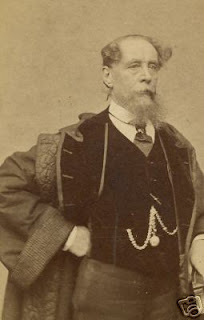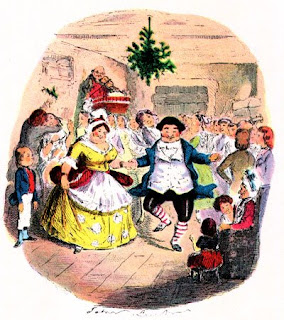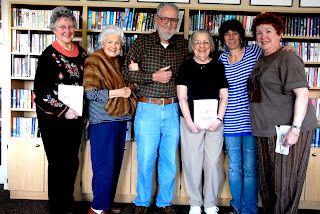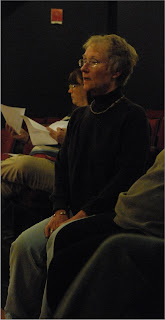Thursday, November 27, 2008
History of MET's A Christmas Carol
Wednesday, November 26, 2008
Reiner Prochaska talks about The Snow Queen
Snow Queen combines a range of compelling themes: good, evil, love, friendship, loyalty, religion, nature, compassion, and ambition. Adapting so complex a story for an audience of children--as well as for their parents and grandparents (since children rarely come to the theater by themselves)--seemed a daunting task. I wanted to write a play that was relevant to a twenty-first-century audience. After I re-read the text several times, two prevalent themes--dichotomies, rather--that seemed to me both modern and timeless emerged: Intellect versus Emotion and Civilization versus Nature.
Both themes have been represented in literature for as long as humans have recorded their experience through the written word. We find them in the Epic of Gilgamesh. Their timelessness intrigued me. Too often, the Snow Queen is a representation of evil and wickedness. I see her as a Force of Nature, rather than a Force of Evil. When Gerda asks Grandmother whether the Snow Queen can come inside, Kai responds, "Let her try! I'd put her on the stove and she'd melt!" If we can accept the Snow Queen as a representation of nature, could Kai's comment be a modern metaphor for human interference with our environment? So, I chose to write this play as a cautionary tale about the precarious balance between Man and Nature, but also about the power of love and loyalty in the face of adversity.
Because I am also directing this production, staging it for visual impact was a big consideration for me. Since so many of the scenes take place in the vast landscapes of Scandinavia, a traditional set seemed hardly appropriate. While as an actor I love the immediacy of the stage, as a filmmaker I'm thrilled by the excitement of moving pictures. But why not combine the two? I decided to use--instead of a stage set--two large screens onto which still and video images could be rear-projected. These images will serve as set interiors as well as interactive outdoor videos. A combination of stock video clips will create the illusion of the Snow Queen's sleigh flying over glaciers and mountains and above the clouds. This past Tuesday, I traveled to Shartlesville, Pennsylvania, to tape footage from a moving horse-drawn carriage driving through a snowy forest for a scene in which Gerda is captured by a band of robbers.
Below is a short "teaser" with images from the show. Check it out. And, come see the show. I think it will be exciting for children of all ages. See you at the MET!
- Reiner Prochaska
Tuesday, November 25, 2008
Box Office Humor (from Joann!)
For those not familiar with this Comedy Central show, it's a show with real 'crank' phone calls to real victims. Puppets are added as the 'actors' to give visual support to what is happening in the phone calls. So yes, some poor box office guy actually had this conversation! (please don't do this to us!)
Friday, November 21, 2008
The MET Furniture Line
.
...
.
.
.
Mark has also built a new fabulous work table and wood storage unit in the scene shop. Next time you're at the MET, ask for a tour of the Maärk Collection!
Thursday, November 20, 2008
Another Christmas Carol Video
Wednesday, November 19, 2008
Charles Dickens
 .
.His early life began idyllically, but due to his father's imprisonment in Marshalsea Debtor's Prison, Dickens was forced at the age of twelve to leave school and work at Warren's Shoe Blacking Factory. The rest of his family moved into the prison, but Dickens was sent to live with a family friend so he could was to work.
Many of his books are based on his experiences as a child factory worker and the effects of being abandoned by his family.
Fortunately for Dickens (and us!), when his father was released, he made sure Dickens was able to return to school, saving him from a life of factory work.
As an adult, Dickens held several jobs, including working as a clerk at a law office and for a newspaper as a political journalist. His first published work for fiction was Sketches by Boz, which was published in 1836 and led to the serialization of his first novel, The Pickwick Papers.
Also in 1836, Dickens married Catherine Hogarth. They had 10 children.
Dickensian characters—especially their typically whimsical names—are among the most memorable in English literature. The likes of Ebenezer Scrooge, Fagin, Mrs Gamp, Charles Darnay, Oliver Twist, Micawber, Abel Magwitch, Samuel Pickwick, Miss Havisham, Wackford Squeers and many others are so well known and can be believed to be living a life outside the novels that their stories have been continued by other authors.
Most of Dickens's major novels were first written in monthly or weekly instalments in journals such as Master Humphrey's Clock and Household Words, later reprinted in book form. These instalments made the stories cheap, accessible and the series of regular cliff-hangers made each new episode widely anticipated. American fans even waited at the docks in New York, shouting out to the crew of an incoming ship, "Is Little Nell dead?"
Charles Dickens died on June 9, 1870. Contrary to his wish to be buried in Rochester Cathedral, he was laid to rest in the Poets' Corner of Westminster Abbey. The inscription on his tomb reads: "He was a sympathiser to the poor, the suffering, and the oppressed; and by his death, one of England's greatest writers is lost to the world."
For more on Dickens, including TONS of analysis of every word he wrote, visit here.
Tuesday, November 18, 2008
A Christmas Carol Fast Facts

Monday, November 17, 2008
A Christmas Carol is almost here...again!
For starters, let's look at some other A Christmas Carol adaptations:
The Muppets!
Scrooge McDuck!
annnnd...Barbie!
Friday, November 14, 2008
MET in the Community: Buckingham's Choice
By Ivan Menchell
.
The play is a comedy-drama concerned with the serious subjects of death, love and renewal of life. There are three widow ladies who have been visiting their husbands’ graves for a number of years. However, a certain amount of unrest has developed within two of the ladies who feel life may have some other purpose for them. The third lady remains devoted to her husband memory and is steadfast in her visits. This sets up a conflict when, by chance, a man appears to visit his wife’s grave and they all accidentally bump into each other. Apparently two of the ladies know this man and the complications and intrigue that develop will both sadden and amuse you. How does one begin anew and should they, are the basic questions that are asked, and does anyone have the right to interfere. The play has some very funny lines in a Jewish New York flavor but the play does more than represent the ethnicity of New York. The problems presented to senior citizens who have lost a loved one are universal and this play will prove very meaningful to many of us.
.
 The cast and director: Marianne, Jill, George, Anne, Julie Herber and Bryce
The cast and director: Marianne, Jill, George, Anne, Julie Herber and Bryce
The Buckingham’s Choice Players are in their final weeks of rehearsal for their 5th presentation of plays given for and by the residents of Buckingham’s Choice, a senior citizen retirement community in Adamstown, Maryland. The plays are directed by a professional actress and director, Ms. Julie Herber, Associate Artistic Director of the Maryland Ensemble Theatre (MET) in Frederick, Maryland.
.
Our performers are senior citizens with many years of life’s experience behind them to guide their understanding of the characters they play. They are used to being natural and real in real-life situations and it just needs a little prompting and coaching from Ms. Herber to make them appear this way before an audience.
.
.
.
.
a) The importance of appearing natural and relaxed. The actors must believe they are in a real-life situation and adapt their own personality to the character they play. The actors must whole heartedly believe in their “imaginary circumstances”.
b) Also, the importance of learning to listen to what the other actor is saying and responding in a meaningful and appropriate way.
c) The need to be responsive to the things about them and to feel familiar with the immediate environment and to relate to the articles (props) that are about them.
d) Allow themselves to show emotional response to changes in events, circumstances and other actors as their personality-character dictates.
e) Showing memory of past events so that their responses (lines) reflect and color the manner of their response. This is achieved by having a full character history developed through the rehearsal process.
f) The importance to remember that every line has a meaning and should be motivated by the feelings of the actor.
g) Once the actors have established their character, they must remain consistent with that part, especially if it is a character that is distinct from their own personality.
.
Marvin S. Fink, President, BC Players
.
Want to see the show?
Wednesday, November 12, 2008
Crumpet the Elf a.k.a. Rona Mensah
 Longtime Ensemble Member Rona Mensah will star in the one-person show, The Santaland Diaries, this holiday season. Who is Rona and how did she come by this amazing opportunity to memorize a 40 page monologue? Here, in her own words, is Rona's life story...the Reader's Digest version:
Longtime Ensemble Member Rona Mensah will star in the one-person show, The Santaland Diaries, this holiday season. Who is Rona and how did she come by this amazing opportunity to memorize a 40 page monologue? Here, in her own words, is Rona's life story...the Reader's Digest version:I came to Frederick to study at Hood College. While there, I participated in the Hood Theatre group. At the time, there were no Theatre Arts courses at Hood so I chose something equally creative: Interior Design and Retail Management.
Even though I was studying something different, I spent much of my free time working on the theatre productions and helping to build the sets, coordinating the properties and acting. Since I didn't stray too far from the campus, I was clueless to the number of theaters in Frederick's bustling arts scene.
After I graduated, I moved to Frederick and quickly learned there were a number of theatre groups in the area and saw a few productions. After about 2 years, I knew I wanted to get back into the theatre scene and wanted to hit the stage again.
I began working for Key 103 radio in Frederick and came into contact with an audition notice for Fredericktowne Players' production of Camelot. It was exactly the jolt I needed to return to the stage. I was lucky enough to get roles onstage with Fredericktowne Players, Other Voices, and Feste Productions theatre groups.
While performing in Feste's Skin of Our Teeth, I came in contact with Maryland Ensemble Theatre founder, Tad Janes who approached me about taking acting classes with The Ensemble School...MET's Educational arm. I started taking classes in Acting and Improvisation with the MET, and in the process grew to learn much more about Theatre Arts and the Ensemble Theatre model.
In 1997, we debuted our premier piece, an original work called "Finally Heard: Feminine Heroes of an Uncivil War". In the 10 years that I've been involved with the MET, we've created 5 original shows and have another one we are creating for the 2008-2009 season. The group has grown and continued to expand our boundaries by creating new original plays, and adapting classic plays with a new twist. It's such a great group to be involved with.
I really love living and working in Frederick. It's such an interesting and eclectic town. There's so much to explore in the arts, from music, to visual and performing arts, one could always be occupied with experiencing the arts in Frederick!
Tuesday, November 11, 2008
A Doll's House interview on WYPR
You can listen to the interview here. You have to scroll down a bit, we're the last item under "Tuesday, November 11, 2008."
Monday, November 10, 2008
David Sedaris on Letterman
Sunday, November 9, 2008
David Sedaris
For a brief bio, go here or here.
For a 2004 interview with Mr. Sedaris, go here. I think the highlight is at the end when he talks about finally getting a computer: "When I was working on a typewriter and I whited out a line, often I would choose a word to go in the space just because it fit. Now I don't have to do that."
For an interview about his 2001 book, Me Talk Pretty One Day, go here.
For a review of his latest book, When You Are Engulfed in Flames, go here. You can also listen to Mr. Sedaris read from the book.
Other books by Daivd Sedaris:
Naked
Dress Your Family in Corduroy and Denim
Barrel Fever
He has also co-written several plays with his sister, Amy Sedaris.
David Sedaris will be at the Weinberg Center in April, 2009.
Friday, November 7, 2008
Santaland Diaries First Read Thru
 The production team, plus a few others: Sarah Shulman (ASM), Mak Nichols, Suzanne Beal (Director), Karina Wright (Stage manager), Joann Lee (Set designer), Tom Majarov (sound designer) and Sarah Straw.
The production team, plus a few others: Sarah Shulman (ASM), Mak Nichols, Suzanne Beal (Director), Karina Wright (Stage manager), Joann Lee (Set designer), Tom Majarov (sound designer) and Sarah Straw.Wednesday, November 5, 2008
Words from Joe
 There are hundreds of moments in “A Doll's House,” instants of emotion and expression that, linked together, tell the story nearly as much as the words themselves. I have come to know this, because I have watched the play as it was created, from the first time it was read, through it's revisions (and revisions), rehearsals, direction, construction, and finally, performance. I have tried to capture those moments in the photographs I've taken over the past weeks as the author, director, designers, and cast created them. I know there are hundreds of moments; I have hundreds of photographs to prove it.
There are hundreds of moments in “A Doll's House,” instants of emotion and expression that, linked together, tell the story nearly as much as the words themselves. I have come to know this, because I have watched the play as it was created, from the first time it was read, through it's revisions (and revisions), rehearsals, direction, construction, and finally, performance. I have tried to capture those moments in the photographs I've taken over the past weeks as the author, director, designers, and cast created them. I know there are hundreds of moments; I have hundreds of photographs to prove it.Brian Irons as Torvald. © 2008 Joe Williams
I started taking photos of MET productions when my wife, Kayte, appeared in “A Threepenny Opera.” I quickly found that theatre lighting is difficult, that many moments I try to capture are ruined by motion during an exposure that is too long, or the shadow on one side of an actor's face is matched by the bright light on their other cheek. Fortunately, I don't pay for film with a digital camera, so I can take some chances and try to capture some of those fleeting instances. It takes a lot of time to sort through all the files. It can be discouraging to see how many times I missed a moment, through a fault in composition, exposure, or movement, but there are also dozens of keepers that make me forget the frustration. Scroll down through the blog, and you'll see some of the results.
The cast and crew, along with Tad and Vibeke, welcomed me and allowed me to observe and document their work as they gave shape to Ibsen's words. By the time the play opened, I had heard some scenes 7 or 8 times, but it was never stale or repetitive. There was always either the drama of the play itself, or the drama (and occasional comedy) of the evolving production. One night soon, I look forward to being an ordinary member of the audience. That night, I'm going to leave the camera at home.









